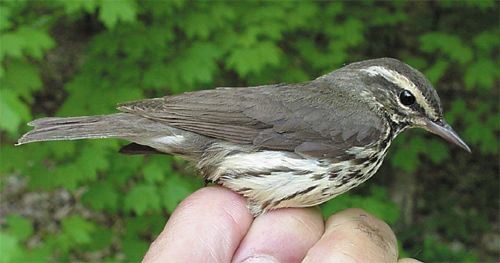 HOME: www.hiltonpond.org |
|||
- The Piedmont Naturalist -
© Bill Hilton Jr.
 HOME: www.hiltonpond.org |
|||
- The Piedmont Naturalist -
© Bill Hilton Jr.
|
The following article is reprinted and revised from |

All text, drawings & photos © Hilton Pond Center
Northern Waterthrush
|
In my first column six weeks ago, I mentioned that one thing I especially like about South Carolina's Piedmont region is its tremendous diversity of flora and fauna. Over the past two weekends, my opinions about our animal diversity have been reinforced considerably. At Hilton Pond in York I maintain a permanent bird-banding facility under the auspices of the U.S. Fish and Wildlife Service. During colder months I stock many types of feeders and use the seeds in them as lures for winter bird residents. In return for this gourmet spread, I capture birds in a variety of harmless traps and fit them with individually-numbered leg bands that allow identification if they are found again near York or elsewhere. During warmer seasons, birds are far more interested in natural food sources like wild fruits, worms, and grubs, so getting them to come to less nutritious seed feeders is next to impossible. At these times, I resort to 10' x 42' "mist nets"--devices that resemble giant hair nets. These nets get their name from being almost invisible when they are strung from poles at ground level, and birds in search of natural foods often blunder into them. Again, little physical harm can come to these birds since I check the nets at least every hour and quickly extricate captives from the tangle in which they find themselves. The remarkable thing about catching birds with nets is that the operation depends upon random accidents in which individuals or flocks just happen to be flying where a net just happens to be. Considering that birds can fly much higher than my 10' nets, it's amazing to me that I ever catch any! When I was a full-time graduate student in ornithology, I used to lie awake nights thinking of the best possible locations to enhance effectiveness of my nets. Over the past four years at Hilton Pond I think I've found the most productive locales, and these include net lanes perpendicular to the pond shoreline, along a fencerow, under a mulberry tree, at the edge of an old field, in a small hardwood grove, and in several other spots. I spend most spring weekends tending the nets and banding migrant birds. Unfurling nets and checking them frequently along our mile or so of nature trails is pretty time intensive, and it's only through the good graces and support of my wife and sons that I can let my household obligations slide during late April, May, and early June--the prime times for avian migration and banding. The past two weekends have been particularly rewarding, and as a bander/ornithologist I am ecstatic at the numbers and kinds of birds that have been moving onto or through the Hilton Pond property. During the weekend of 2-4 May, I banded 117 individuals of 33 bird species, and last weekend (9-11 May) 82 individuals of 32 species hit the nets; some of these species differed from one weekend to the next. To think that 32 or 33 different species of birds were in my yard on a given weekend in May simply boggles my mind, and even more amazing to me is that the actual species total from the ten-day period was 45!
Again, I am amazed by the diversity of 45 species of birds banded on our little 12-acre homestead. I wonder how many I could have banded if I'd taken the whole week off instead of teaching.......? BANDING TOTALS-----HILTON POND---YORK, SC American Goldfinch 27 All text, drawings & photos © Hilton Pond Center |
|
Make direct donations on-line through
Network for Good: |
|
|
LIKE TO SHOP ON-LINE?
Donate a portion of your purchase price from 500+ top on-line stores via iGive: |
|
|
Use your PayPal account
to make direct donations: |
|
 post questions for The Piedmont Naturalist |
Join the |
Search Engine for |
|
|